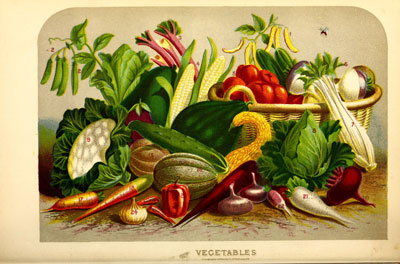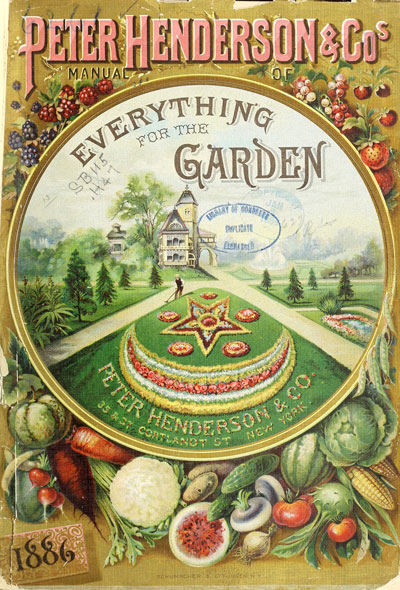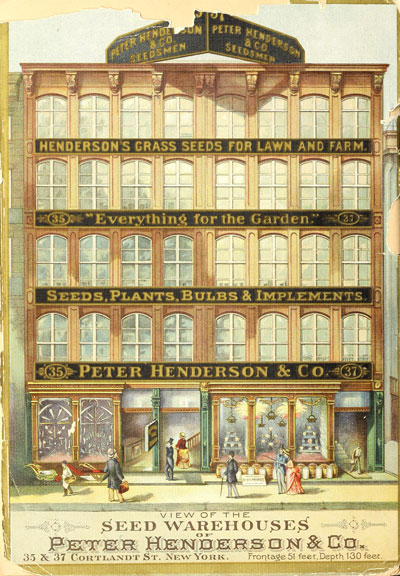Seeds in the Stacks: A Closer Look at Two Seedsmen from the Golden Age
The National Agricultural Library (NAL), Special Collections has one of the world’s largest collections of nursery and seed trade catalogs totaling over 200,000 from American as well as international companies. This collection, representing businesses located in all states plus over 50 countries, was named after its long-time curator, Henry G. Gilbert. The earliest catalog is from William R. Prince & Company dated 1771. NAL continues to collect modern-day catalogs.
The collection was begun by Percy Ricker, U.S. Department of Agriculture’s first economic botanist. Through the course of his work, he traveled to many plant nurseries throughout the country and collected duplicate copies of their catalogs. When he retired in the 1940s, he had amassed over 70,000 catalogs, and the collection grew from there.
NAL has been systematically digitizing its seed trade catalogs with over 41,000 catalogs available online through the Biodiversity Heritage Library (BHL) as well as Internet Archive. The bulk of the holdings begin in the late 1800s, which is considered the golden age of mail order catalogs.
James Vick and Peter Henderson are two men who epitomized that golden age.
James Vick and Sons
James Vick (1818-1882) started in the seed business in 1860. Born in England, he immigrated with his family to New York in 1833 and would go on to influence the nursery and seed trade catalog business with beautiful color illustrations and much more.

James Vick and Sons Charles, James, and Frank. Vick’s Floral Guide, 1889. Digitized by the U.S. Department of Agriculture, National Agricultural Library.
Prior to getting into the seed business, Vick was a printer for newspapers, experience which helped make his Floral Guides eye-catching. The first one was published in 1862. Vick used chromolithography in several of the guides, creating beautiful horticultural images. In fact, he was a pioneer in mass-producing color illustrations in mass-market catalogs as demonstrated by his 1864 catalog that contained a full-page chromolithograph of double zinnias. His images became so popular that he produced a set of large prints that were either sold separately or given with large orders.

Vick’s Garden and Floral Guide, 1898. Digitized by the U.S. Department of Agriculture, National Agricultural Library.
In addition to being a skilled printer, Vick was a successful writer, editor, publisher, and owner of several well-known horticultural publications, so he knew how to connect with people. He developed a personal, chatty style of communication. In addition to information on seeds and plants, his guides shared gossip, correspondence, gardening advice, and a special children’s section as well as space for a complaints forum (for example, the high price of postage).

Vick’s Illustrated Floral Guide, 1873. Digitized by the U.S. Department of Agriculture, National Agricultural Library.
Throughout Vick’s life, he was constantly trying to improve his business. In the mid-19th century, the best seeds came from Europe. American seeds had an inferior reputation at the time. He wanted to grow high-quality seeds in America and went to Europe to study the methods of the Old World (in particular the effects of climate). In the 1873 Vick’s Illustrated Floral Guide, he shared the results of his studies with readers.

Vick’s Flower and Vegetable Garden, 1878. Digitized by Smithsonian Libraries.
In addition to his guides, he published a book titled Vick’s Flower and Vegetable Garden and Vick’s Illustrated Monthly magazine. He followed a pattern with lovely etchings, essays, conversation, and beautiful color plates.

Vick’s Seed House, 1880. Vick’s Floral Guide, 1881. Digitized by the U.S. Department of Agriculture, National Agricultural Library.
James Vick and Sons was extremely successful, growing the business to include flower farms and a five-story seed house that included a printing office, bindery, box-making establishment, and artists’ and engravers’ rooms. It was a self-contained business and was one of the largest and most well-run seed houses of its time. It had 300 orders and 3,000 letters a day, and its publications reached an annual circulation of 250,000. While its products were excellent, much of its success was due to James Vick and his understanding of the power of connecting and engaging with the customer. His sons carried on that tradition until the early 20th century when the company was sold to Burpee Seed Company.
Peter Henderson
Another nurseryman whose catalogs enjoyed widespread distribution during the “Golden Age” of the mail order catalog business was Peter Henderson (1822-1890). One of the leading authorities on commercial floriculture of the time, he simplified and improved methods of handling plants for commercial purposes. He was head of Peter Henderson & Company, a seed and supply business. The company’s thick catalogs reflected Henderson’s sales concept of “Everything for the Garden” and offered seeds, bulbs, fertilizers, insecticides, and gardening and lawn tools. A prolific writer, Henderson gained popularity through his willingness to share horticultural techniques in his descriptive catalogs, books, articles, and letters.

Peter Henderson & Co.’s Manual of Everything for the Garden, 1886. Digitized by the U.S. Department of Agriculture, National Agricultural Library.
Born in Scotland in 1822, Henderson showed an early aptitude for handling plants. Perhaps his talent was inherited from his maternal grandfather who was a nurseryman and florist. Beginning at age 16, he apprenticed to head gardener George Sterling at Melville Castle. The following year, Henderson won a gold medal for the best herbarium of native and exotic plants submitted to the Royal Botanical Society of Edinburgh for a competition throughout Great Britain.
Scottish nurseryman Robert Buist’s property. Buist’s Garden Seeds, 1894. Digitized by the U.S. Department of Agriculture, National Agricultural Library.
In 1843, he immigrated to the United States and obtained employment as a gardener for several other Scottish nurserymen, including George Thorburn and Robert Buist. He remodeled Charles F. Spang’s greenhouses and grounds. In 1847, Peter and his brother James began a business growing vegetables in New Jersey and marketing them in nearby New York City.
Several years later, the brothers parted ways. Peter began growing and selling ornamental plants from his Jersey City property. In 1871, he founded Peter Henderson & Company and established a seed house and store in New York on Cortlandt Street. In 1880, from his property in nearby South Bergen, he erected state-of-the-art greenhouses with innovative heating and ventilation systems. The location of these greenhouses in the Jersey City area meant that his inventory could be transported conveniently across the country by means of rail and water ways.

Peter Henderson & Co. located at 35-37 Cortlandt Street, New York City. Peter Henderson & Co.’s Manual of Everything for the Garden, 1886. Digitized by the U.S. Department of Agriculture, National Agricultural Library.

Peter Henderson & Co. greenhouses. Peter Henderson & Co.’s Manual of Everything for the Garden, 1885. Digitized by the U.S. Department of Agriculture, National Agricultural Library.
Henderson was willing to share his knowledge on gardening topics with the public, even though it meant letting his competitors know about his research. He contributed articles to magazines such as Hovey’s Magazine of Horticulture, The Horticulturist, Gardener’s Monthly, The Country Gentleman, and Moore’s Rural New-Yorker. His son Alfred wrote in Henderson’s biography that the American Agriculturist desired all his writings so they “…paid him a price per column that has been considered perhaps the largest rate ever paid an American writer.”

Gardening for Profit, revised in 1874. Copy in BHL digitized by the Library of Congress.
The U.S. Department of Agriculture asked him to write an article on market gardening for the Report of the Commissioner of Agriculture for the Year 1865. The public’s interest in the subject led to Henderson writing his first book, Gardening for Profit (1866), the first of its kind about commercial marketing of vegetables. He went on to author four more books, including Practical Floriculture (1868), Gardening for Pleasure (1875), Garden and Farm Topics (1884), and Henderson’s Hand Book of Plants (1881). He co-authored How the Farm Pays (1884) with William Crozier, one of the most successful farmers in the United States.
“““““““““““
“To supply a population of a million inhabitants daily, throughout the year, with fresh vegetables would, it might be supposed, require an immense tract of land. Such, however, is not the case.”
Peter Henderson, “Market Gardening in the Vicinity of New York.” Report of the Commissioner of Agriculture for the Year 1865. (Page 243)
“““““““““““`

Peter Henderson & Co.’s Manual of Everything for the Garden, 1909. Digitized by the U.S. Department of Agriculture, National Agricultural Library.
Henderson’s popular articles and books attracted customers for his plant and seed business. He wrote his own plant descriptions for his catalogs until 1890. He created clever and original advertisements. In fact, he was the first to use a heavy black border around his advertisements. Another reason for his popularity was his prompt and detailed response to correspondence. According to son Alfred in 1890, “…in the last thirty five years he wrote or dictated at least one hundred and seventy-five thousand letters.” He replied to correspondents the same day he received their letters, no matter how tired he was from the rigors of outdoor work and running a business.

An illustration of a gardener frequently appears in Henderson’s catalogs. Perhaps this figure represents Henderson. Bulbs, Plants, Seeds for Autumn Planting, Peter Henderson & Co., 1892. Digitized by the U.S. Department of Agriculture, National Agricultural Library.
Henderson even traveled long distances to give advice to entrepreneurs on such topics as land suitability, best plants to raise on the property, and greenhouse construction. It was the willingness of this leading florist, seed merchant, and horticultural writer to share knowledge that advanced horticulture from an art form to a science.
James Vick and Peter Henderson were shrewd businessmen who had great influence on the nursery and seed trade business through their catalogs, innovation, and personal styles. They became like friends to their readers and Vick’s seeds or Henderson’s opinions were often sought after. But, these were men who cared about horticulture both as art and science as well as business. They believed that gardening was an uplifting, healthy pursuit and wanted to promote the beauty of horticulture in addition to running successful businesses.
Bibliography
Bailey, Liberty Hyde. The Standard Cyclopedia of Horticulture. Volume III -F.-K. Page 1579. New York: The MacMillan Company, 1915.
Becker, Robert F. “Peter Henderson: Plant Pioneer.” American Horticulturist, 74, no. 12 (December 1995): 24-30.
Christopher, Thomas. “Heirloom Seed Catalogs.” Horticulture 63, no. 12 (December 1985): 24-27.
Henderson, Alfred. Peter Henderson, Gardener-Author-Merchant: A Memoir. New York: McIlroy and Emmet. 1890. Accessed on March 19, 2018. https://archive.org/details/peterhendersonga01hend.
Henderson, Peter. “Market Gardening in the Vicinity of New York.” Report of the Commissioner of Agriculture for the Year 1865. Washington, D.C.: Government Printing Office, 1866.
McIntosh, W.H. History of Monroe County, New York: With Illustrations, Descriptive of its Scenery, Palatial Residences, Public Buildings, Fine Blocks, and Important Manufactories 1788-1877. Philadelphia: Everts, Ensign and Events, 1877.
“Peter Henderson and Company – Peter Henderson and James Henderson.” Jersey City Past and Present. Accessed on March 12, 2018. http://www.njcu.edu/programs/jchistory/Pages/H_Pages/Henderson_Peter.htm.
Ricker, Percy L. and Magdalene R. Newman. The Nursery and Seed Trade Catalog Collection of the United States Department of Agriculture. Washington, 1945. Accessed on April 17, 2018. http://archive.org/details/CAT31064290.
Van Ravenswaay, Charles. A Nineteenth-Century Garden. New York: Universe Books, 1977.
“Vick, James (1818-1882).” n.d. Accessed March 13, 2018. http://www.sil.si.edu/SILPublications/seeds/vickjames.html.







Leave a Comment